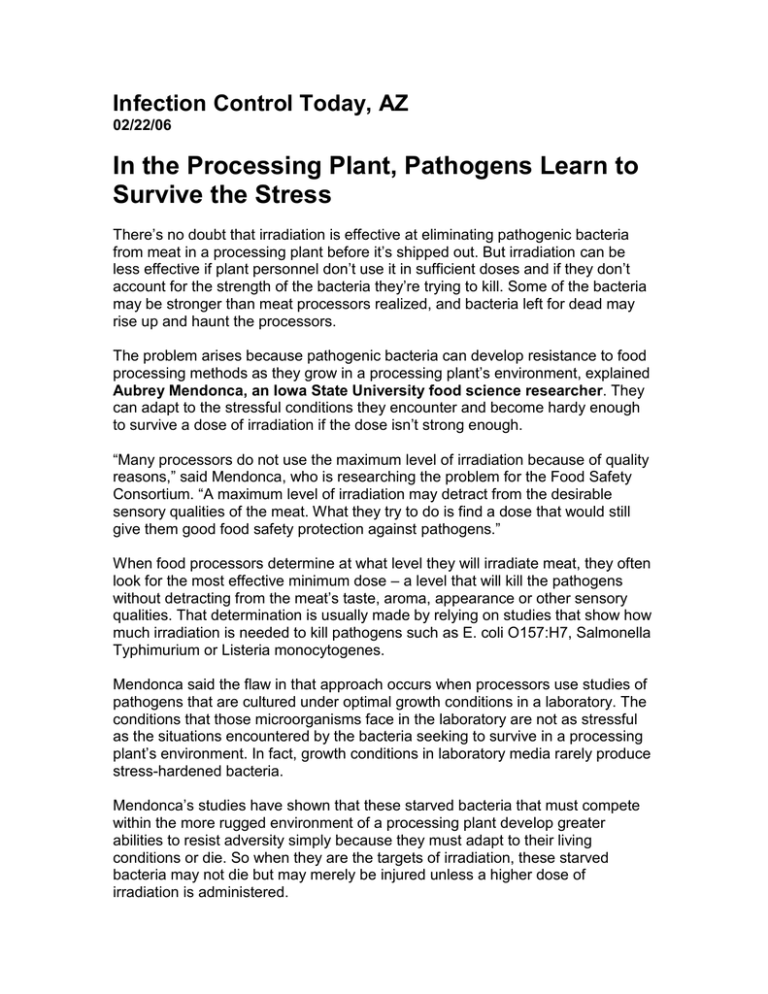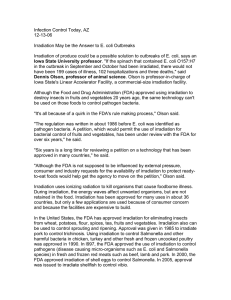In the Processing Plant, Pathogens Learn to Survive the Stress
advertisement

Infection Control Today, AZ 02/22/06 In the Processing Plant, Pathogens Learn to Survive the Stress There’s no doubt that irradiation is effective at eliminating pathogenic bacteria from meat in a processing plant before it’s shipped out. But irradiation can be less effective if plant personnel don’t use it in sufficient doses and if they don’t account for the strength of the bacteria they’re trying to kill. Some of the bacteria may be stronger than meat processors realized, and bacteria left for dead may rise up and haunt the processors. The problem arises because pathogenic bacteria can develop resistance to food processing methods as they grow in a processing plant’s environment, explained Aubrey Mendonca, an Iowa State University food science researcher. They can adapt to the stressful conditions they encounter and become hardy enough to survive a dose of irradiation if the dose isn’t strong enough. “Many processors do not use the maximum level of irradiation because of quality reasons,” said Mendonca, who is researching the problem for the Food Safety Consortium. “A maximum level of irradiation may detract from the desirable sensory qualities of the meat. What they try to do is find a dose that would still give them good food safety protection against pathogens.” When food processors determine at what level they will irradiate meat, they often look for the most effective minimum dose – a level that will kill the pathogens without detracting from the meat’s taste, aroma, appearance or other sensory qualities. That determination is usually made by relying on studies that show how much irradiation is needed to kill pathogens such as E. coli O157:H7, Salmonella Typhimurium or Listeria monocytogenes. Mendonca said the flaw in that approach occurs when processors use studies of pathogens that are cultured under optimal growth conditions in a laboratory. The conditions that those microorganisms face in the laboratory are not as stressful as the situations encountered by the bacteria seeking to survive in a processing plant’s environment. In fact, growth conditions in laboratory media rarely produce stress-hardened bacteria. Mendonca’s studies have shown that these starved bacteria that must compete within the more rugged environment of a processing plant develop greater abilities to resist adversity simply because they must adapt to their living conditions or die. So when they are the targets of irradiation, these starved bacteria may not die but may merely be injured unless a higher dose of irradiation is administered. “For example, if I go to the literature right now it says you can eliminate 100,000 Salmonella cells in chilled ground beef with about 3 kiloGrays (the measurement unit for irradiation dosages),” Mendonca said. “These data are not based on the highly resistant cells. They’re based on cells grown in the laboratory. So the processors might have a false sense of security in using less of an irradiation dose to save quality and believing that they’re actually eliminating the pathogen.” The solution would be for processors to base their irradiation levels on what it takes to kill stress-adapted organisms instead of laboratory-grown organisms, he said. Government regulations limit how high a dose of irradiation is allowed, but the rules do not set a minimum level for those processors who choose to irradiate. Processors generally do not want to use the maximum dose when irradiating, but they might not need to do so. Mendonca pointed out that irradiation destroys bacteria exponentially – increasing in powers of 10 – so relatively small increases in irradiation dose can significantly raise effectiveness of the process. Mendonca’s results were gathered from experiments testing the ability of starved cells of Salmonella Typhimurium to survive following the irradiation of ground pork. Additional research would be needed to evaluate the resistance capabilities of other stress-adapted foodborne pathogens. Industry is becoming aware of the need to watch for the resistant bacteria. Mendonca noted that some processors are starting to rotate sanitizers because the constant use of one sanitizer could enable microorganisms to become resistant. “Many processors use two or three different sanitizers and will change every month,” he said. Source: Iowa State University


